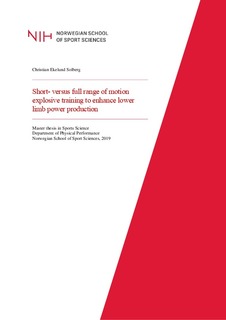| dc.description.abstract | Introduction: Resistance training for sports requiring explosive movements is often performed over the full range of motion (ROM). Interestingly, training with either explosive dynamic or isometric contractions have showed to result in similar increase in dorsiflexor torque at high velocity and rate of torque development (RTD). The purpose of this study was to test the hypothesis that explosive full ROM and very short ROM knee extensions would result in similar increase in isokinetic full ROM knee-extension torque and power production in leg press.
Method: Sixteen volunteers underwent a 10-week resistance training program using a leg press machine. Training was performed unilaterally, with each leg assigned to very short ROM or full ROM, explosive contractions. Both legs were exercised from 90˚ knee-flexion (180˚ = extended knee). Measurements included muscle architecture (vastus lateralis), voluntary and electrically induced RTD of knee extensor muscles, and isokinetic knee-extension torque at 30˚s-1, 60˚s-1, 180˚s-1 and 300˚s-1. In addition, peak power and force were measured during full ROM leg press (80-180˚ knee angle).
Results: The two training schemes resulted in similar functional improvement in leg press and isokinetic knee extensions. Both training modalities led to similar increase in power at various loads configurations, and a greater isokinetic knee-extension torque at 180˚s-1 and 300˚s-1, but not at lower velocities. Voluntary and electrical evoked knee extension torque increased in both training modalities, however, very short ROM training led to a significant greater improvement in voluntary torque at 150 ms after torque onset.
Conclusion: These results extend previous findings by showing that explosive resistance training of the knee-extensors muscles lead to similar adaptions, irrespective of the ROM during the training. The functional improvement at higher velocities is thought to be associated with the increase in RTD. The greater RTD is ascribed to neural and muscular adaptations improving rapid force production in the early phase of the ROM, when most of the muscle force and work can be produced. Hence, owing to the greater work produced by the muscle fibers in the initial part of the contraction, explosive training with very short ROM contractions may be just as effective as dynamic contractions to improve functional performance over full ROM. | nb_NO |
